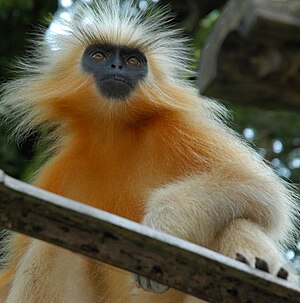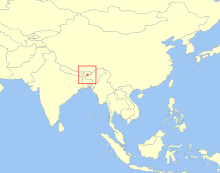Golden langur
| Golden langur | ||||||||||||
|---|---|---|---|---|---|---|---|---|---|---|---|---|

Golden langur |
||||||||||||
| Systematics | ||||||||||||
|
||||||||||||
| Scientific name | ||||||||||||
| Trachypithecus geei | ||||||||||||
| ( Khajuria , 1956) |
The golden langur ( Trachypithecus geei ) is a species of primate from the group of the Schlankaffen (Presbytini).
features
Gold langurs reach a head body length of 49 to 72 centimeters, plus a 71 to 94 centimeter long tail. Their weight is 9.5 to 12 kilograms, making them one of the heavier representatives of the crested langurs . The coat color varies from cream to golden yellow, in winter it tends to take on a reddish tinge. The dark face is surrounded by long hair that forms the crest typical of the crested langur on the top.
distribution and habitat
Gold langurs are native to the west of the Indian state of Assam and Bhutan . Their habitat are tropical forests.
Way of life
Golden langurs are diurnal tree dwellers that retreat to the higher layers of the trees to sleep. They live in groups of 2 to 12 animals, these are made up of one or two males, several females and their offspring. The range of the individual groups can overlap.
They are herbivores that feed primarily on leaves and fruits. Like all slim monkeys, they have a multi-chambered stomach for better utilization of the difficult to digest plant food.
After a gestation period of around six months, the female usually gives birth to a single young in July or August.
threat
The distribution area of the golden langur has been greatly reduced and fragmented by forest clearing, the destruction of its habitat represents the main threat to this species. Parts of its habitat are protected today, such as the Manas National Park . Overall, the type of which is IUCN as endangered ( endangered ) listed.
Systematics
The golden langur, together with the cap langur and the shortridge langur, form the pileatus group within the genus of the crested langur . In addition to the nominate form T. g. geei are found in northern Bhutan with T. g. bhutanensis a second subspecies.
literature
- Thomas Geissmann : Comparative Primatology. Springer-Verlag, Berlin et al. 2003, ISBN 3-540-43645-6 .
Web links
- Trachypithecus geei in the endangered Red List species the IUCN 2006. Posted by: Participants of CBSG CAMP Workshop: Status of South Asian Primates, 2004. Accessed April 26 of 2008.
- Information on Theprimata.com
- Photos and information on arkive.org
